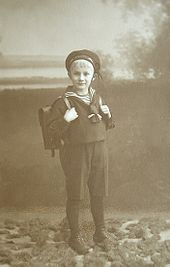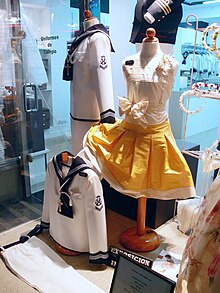Sailor suit
The sailor suit has been introduced in modern times as clothing for sailors in the sense of a uniform . It consists of a shirt, pants and hat. In the 19th century the sailor suit became a popular item of clothing for boys and later also for girls, with trousers being replaced by a skirt. In some countries, school uniforms developed from sailor suits.
history
By the 15th century at the latest, seafarers wore a smock and wide, calf-length trousers. In 1623, ready-made clothing was first issued to the ship's crew in the English Navy (linen jackets - cotton trousers - vests - shirts - stockings - shoes and hats). In the 18th century there were fixed (national) regulations for the clothing of sailors, e.g. B. blue jacket, light blue waistcoat, white pants and blue stockings. Around 1780, the sailor's trousers first became the model for boys' trousers. Around 1830, a dark blue ( navy blue ) suit became the model of the sailor suit: long, wide trousers without a bib and a smock with a wide angular back collar, which in real sailors was trimmed with leather to protect the clothing from tar when the ropes were pulled . This collar is called the drill collar . A typical sailor shirt has no buttons. A flat cap belongs to a complete sailor suit .
The characteristic collar was developed from cloths that sailors of the Prussian Navy wore over their jackets in order to avoid contamination from the prescribed braid, which is often wrapped with a tarred cord .
In 1857, the collar of the training gown of the sailors of the Royal Navy got three white stripes. Rumors persist that the stripes are supposed to commemorate the three victorious naval battles of Admiral Nelson against Napoleon's fleet ( Abukir , Copenhagen and Trafalgar ). However, the Royal Navy sees no connection with the famous battles of Admiral Nelson. The sewn tie was made from the sailors' scarf. Allegedly, the traditional black of this scarf expresses mourning over the death of Nelson in 1805. In 1872/73 the German navy introduced the woven, blue diagonal stripe that runs from top right to bottom left and marked the silk scarf as fiscal property. Between 1939 and 1945 the blue stripe was worn differently in the Navy . Members of the North Sea units carried the stripe running from bottom right to top left; the members of the Baltic Sea units carried the stripe from bottom left to top right.
In the middle of the 19th century this sailor suit became typical clothing for boys from wealthy circles. In 1880, sailor blouses for girls with blue pleated skirts became popular. In the time of National Socialism , this item of clothing was rejected as bourgeois-decadent. In the 1950s, the sailor look found its way into casual fashion for adults and never went completely out of fashion.
The navy's uniform
Even today, the sailor suit is widespread in the navy, so it is worn by crew ranks in the German Navy .
The German sailor's clothing was manufactured centrally in Kiel in the German Reich , which is why it was nicknamed the Kiel suit . In the USA, the clothing of sailors was first specified precisely in 1817.
Children's clothing


In the second half of the 19th century, the sailor suit was the typical garment for boys in Great Britain, Germany and France. The sailor suit was particularly fashionable from 1870 to the 1930s. For the first time, a special piece of clothing was used for children, which did not represent the image of everyday clothing for adults. The most common color was blue, followed by white. The appearance was very similar to that of the naval uniforms, including the collar and stripes. However, the pants were mostly short. For girls, sailor clothes in the same style became fashionable. The introduction of the sailor suit into children's fashion is attributed to the British royal court.
In 1846, a child-sized naval uniform was made for the then five-year-old Prince of Wales, who would later become King Edward VII . He wore this on a portrait that the painter Franz Xaver Winterhalter made of him and that first made the sailor suit popular among British aristocratic circles, and from around 1860 also among the rest of the population. The British Queen Victoria also gave such a suit to her grandson Wilhelm, who later became Wilhelm II. As a result, the sailor suit became known and very quickly popular in Germany. These clothes went very well with the enthusiasm for the Imperial Navy that was widespread at the time . Bleyle is said to have brought the first industrially manufactured sailor suits in Germany onto the market in 1890 .
The Japanese school uniform
→ Main article: School uniforms in Japan
At many Japanese middle and high schools, girls wear a sailor suit as a school uniform ( Japanese : セ ー ラ ー 服Sērāfuku ). It was introduced for the first time in 1921 at the Fukuoka Girls' Academy (福岡 女 学院Fukuoka jogakuin ) by director Elisabeth Lee based on the model of her sportswear in Great Britain . Sailor clothing soon found its way across the country as a girls 'school uniform, while the boys' school uniform was mostly based on the ( Prussian ) army uniform. Classically, apart from the white stripes, the sailor shirt and skirt are kept in a dark blue throughout; Nowadays school uniforms are usually more colorful, with the colors dark blue, white and gray dominating.
Sailor clothes as school uniform in Hungary
Sailor clothes (blouse and skirt) have been the school uniform in most Hungarian high schools and middle schools for more than a hundred years . It is interesting because Hungary no longer has a sea coast or a navy. Its use was probably taken over from Germany around 1900 . Sailor clothes are only used as uniforms for girls, but not for everyday school life, but only for festive occasions.
Others
In Spain, sailor suits are traditionally worn by boys as festive clothing for first communion .
The Vienna Boys 'Choir , the Zurich Boys' Choir and the boys in the St. Thomas Boys Choir perform in sailor suits at concerts.
The well-known cartoon character Donald Duck from Walt Disney basically wears a sailor suit that has changed several times over the years. Originally the suit was white with blue stripes without a bow tie, afterwards the suit was blue with white stripes or gold stripes and buttons and a blue cap. At the moment the suit is either as described in second place or black with gold stripes and buttons. Donald Duck usually wears the unusual red bow tie.
Individual evidence
- ^ Nicole Tiedemann : hair art . On the history and meaning of the human piece of jewelry. Böhlau, Cologne 2007, ISBN 978-3-412-05906-4 , pp. 130 . ( limited online version in Google Book Search - USA )
- ^ Letter from the Deputy Naval Attaché to the Defense History Training Center of the Mürwik Naval School dated July 30, 1984
- ^ Naval Office, The History of the Sailor Uniform, 1984
literature
- Walter Hävernick : Children's clothing and group spirit from a folklore perspective. I: The sailor suit of Hamburg boys 1900–1920 . In: Museum for Hamburg History (Hrsg.): Contributions to German folklore and antiquity . tape 4 . Hamburg 1959, p. 37-61 .
- Robert Kuhn / Bernd Kreutz: The sailor suit. Cultural history of a garment . 1st edition. Harenberg Edition, Dortmund 1989, ISBN 3-88379-576-3 , pp. 208 .
- Dora Lühr: sailor suit and dress. Development history of children's fashion from 1770 to 1920 . In: Contributions to German folklore and antiquity . tape 5 (1960/61) . Hamburg, S. 19-42 .




